6/16/1943 - Oh my, if you ever watched the History Channel show "DOGFIGHTS," specifically the episode "LONG ODDS," you know about "Old 666" and the most decorated crew for one mission in U.S. air force history ... if you don't, here is their tale on the anniversary of their moment.
Only Known Photo Of "Old 666"
In the Pacific Theater, Tail number 41-2666 is a shot up B-17 bomber with a reputation for being cursed named "Hard Luck Hattie," but in need of a ride, Captain Jay Zeamer, Jr. (born in Carlisle, Pennsylvania, in 1918, the pilot is a graduate of the Culver Military Academy in Culver, Indiana, winning marksmanship awards each year he is there, and before the war begins, graduates from M.I.T. with a B.S. in civil engineering, it is also at M.IT. that he gets his aviation license, learning how to fly in the school's flying club) takes on the project of resurrecting the plane from the scrapheap for photographic reconnaissance missions ... engines are replaced, the plane is lightened of all unnecessary gear, and its defensive capabilities are augmented by the addition of dual .50 caliber M2 Browning machine guns in the radio compartment and at both waist positions, and a fixed .50 caliber machine gun is installed in the nose for the pilot to fire ... in all, the bomber will go from having ten guns, to having nineteen, and it becomes the most heavily armed plane in the entire Pacific ... ... on 6/16/1943, it will need every one of them (by the time of his famous mission, 24-year-old Zeamer is his squadron's executive officer and has been awarded a Silver Star for a 1942 photo reconnaissance flight over Simpson Harbor on the island of Rabaul, as well as receiving an Oak Leaf Cluster for a 1943 flight over the same dangerous Japanese held island).

Young Zeamer
Zeamer
Named "Old 666" by the crew to mock the plane being cursed, Zeamer and his crew volunteer for a mission over the island of Bougainville, photographing the Japanese defenses around Empress Augusta Bay (where the Marines will land later in the year) ... a flight of 600 miles over open water before reaching their destination, a volunteer mission because it includes a straight and level run for mapping purposes of twenty-two minutes over extremely hostile territory.
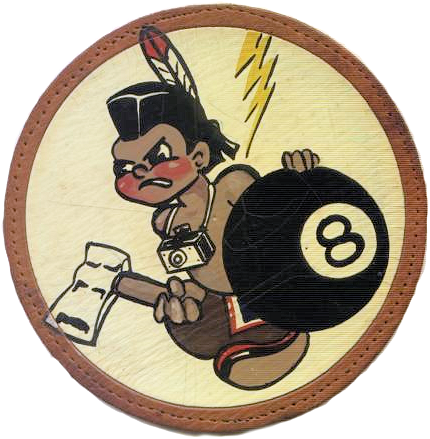
Flight Group Logo

K17 Aerial Camera
Empress Augusta Bay - 1943
Leaving at 4:00 in the morning to use the cover of darkness for their approach through hostile air space, the bomber arrives too early over Bouganville for photography, and after a crew vote, decide to photograph the Japanese airfield on the small island of Buka (off the northern tip of Bouganville, a site the command is desperate for information about) and are quickly pounced upon at roughly 7:40 by either seventeen Zero fighters (the crew's count) or eight Zeroes (the Japanese count) ... whichever the number, the plane is attacked over and over again, while fighting back with its improved arsenal ... and all the while taking the pictures that are its mission.

Buka Airfield

Mitsubishi Zero Fighter
In the aerial battle that takes place, cockpit hit by a 20mm cannon shell, pilot Zeamer Jr. is wounded (his holed left leg is broken both above and below the knee, and he takes shrapnel wounds to both arms, his right leg, and his right wrist ... he uses his own belt to provide a tourniquet for his ruined left leg ... later it will be determined he loses almost half the blood in his body ... a body its takes surgeons over 72 hours to remove almost 150 pieces of shrapnel from and patch up, along with an additional fifteen months for him to recover use of his leg), as is 28-year-old bombardier, Second Lieutenant Joseph Sarnoski (with a neck wound and a hole in his side the size of a bowling ball) from Simpson, Pennsylvania (the second oldest of seventeen offspring of a Polish coal miner).

Sarnoski
Blown out of his station (fifteen feet to a position almost directly under the flight deck), Sarnoski is in the process of seeking medical treatment (sulfa powder poured on his wounds by Ruby Johnston) when the bomber is attacked again, and so he crab crawls forward, mans his nose gun again, and is credited with shooting down two Japanese fighters before collapsing and dying at the weapon (his last act is to kiss his rosary). Oxygen system destroyed (along with the hydraulic system and the pilot's flight instruments ... miraculously, none of the plane's engines are hit), Zeamer is forced to take the bomber down, descending from 25,000 feet to 8,000 feet above the Pacific, and continues to maneuver the plane so as to bring the most guns to bear on whatever Zero is attacking. Finally, at 8:45 in the morning, short on fuel and ammunition, after forty minutes of attacks, the Zeroes break off and return to base (while the crew is credited with five fighters being shot down during the encounter, Japanese records show one plane ditching in the sea due to engine troubles and three other Zeroes being damaged, but making it back to Buka), while the "Old 666" limps back to an alternate base at Dobodura, New Guinea (the plane is unable to climb high enough to get over the Owen Stanley Mountains blocking their home base at Port Moresby) and its 7,000 yards long grass field. Navigational equipment destroyed, dead reckoning is used keeping the sun over the pilot's left shoulder, along with moments of help identifying islands by Zeamer, a naval radio that can send and receive Morse code that is used to map a course home, and a lot of luck), with co-pilot 1st Lt. John.T. Britton (who only has a contusion to his head) flying the bomber after Zeamer finally loses consciousness from his wounds, assisted by top turret gunner Able in the second seat, the shot-to-pieces bomber makes it back to base ... barely
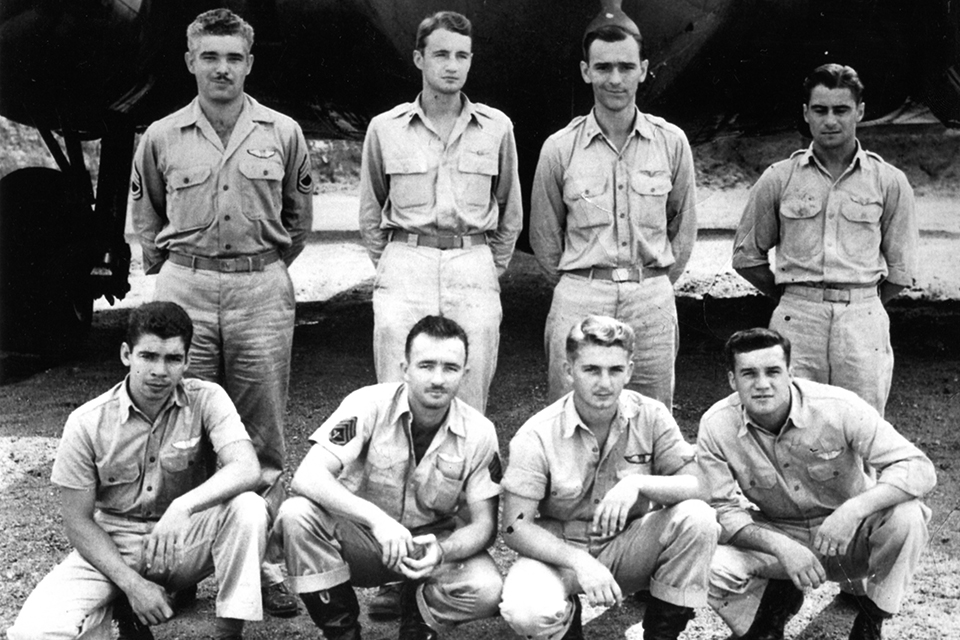
Original "Eager Beavers" - Front Of Sgt. William Vaughn, Sgt. George Kendrick, Sgt. Johnnie Able, Sgt. Herbert Pugh - Rear Of Sgt. Bud Thues, Captain Zeamer, Sgt. Hank Dyminski, 2nd Lt. Joe Sarnoski.- Just Prior To 6/16, Tech Sgt. Forrest Dillman Is Added To The Crew And Lt. John T. Britton And Lt. Ruby Joihnston Replace Dyminski And Thues
Mission complete when the bomber is successfully crash landed in a cloud of dust at 12:15 in the afternoon (the pictures taken will be deemed a major factor in the successful Marine invasion of the island that takes place later in 1943), both Zeamer (one of only nine Eagle Scouts to be so honored, the former Boy Scout is recommended for the medal by Colonel Merian C. Cooper, the former WWI pilot responsible for writing and producing King Kong) and Sarnoski are awarded the Congressional Medal of Honor for the mission (only the third time in American military history two men are awarded the medal for the same mission), and the rest of the crew (known as the "Eager Beavers" for volunteering for missions), navigator Charles Stone (wounded in the arm), co-pilot Britton, William Vaughan (radio operator ... wounded in the neck, he helps plot the course home), George Kendrick (responsible for the photo taking, after storing the exposed film, he mans a waist gun), Johnnie Able (top turret gunner ... wounded in both knees, he puts out a fire at his position with his bare hands and later flies the co-pilot position for the first time), Herbert Pugh (tail gunner), Forrest Dillman (waist gunner) and Ruby Johnston (waist gunner ... wounded in the head) all receive Distinguished Flying Crosses.
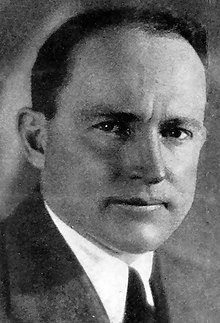
Cooper
A Recovering Zeamer
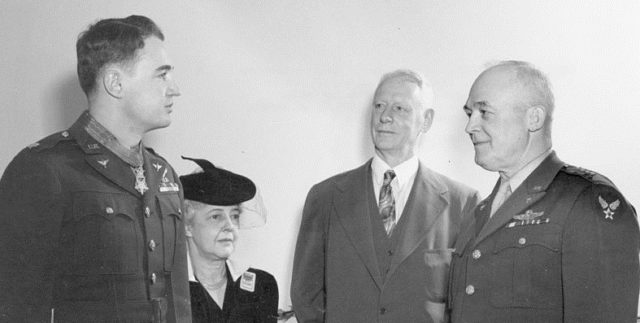
Zeamer, Parents, And Hap Arnold At Medal Of Honor Ceremony
Survived by his wife Marie, Sarnoski will be buried in Hawaii, at the National Memorial Cemetery of the Pacific (Section A, Grave 582). After recovering as best he can from his wounds and receiving the accolades he so richly deserves, Zeamer takes a disability retirement from the United States Army Air Force as a Lt. Colonel in January of 1945 (his service awards consist of the Medal of Honor, two Silver Stars, two Distinguished Flying Crosses, a Purple Heart, and two Air Medals). After the war, the gallant pilot goes back to M.I.T., for a master's degree in aeronautical engineering, and then works at Pratt & Whitney, Hughes Aircraft, and Raytheon in various capacities, while also marrying his wife Barbara and raising five daughters, Marcia, Jacque, Jayne, Susan, and Sandra. He dies in a Boothbay Harbor, Maine nusing home on May 22, 2007 at the age of 88 ... buried at Arlington National Cemetery, on the day of his funeral, the governor of Maine, John Baldacci orders the state's flags be flown at half-mast in the aviator's honor. .
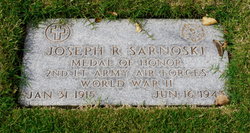
Sarnoski's Final Resting Place

Zeamer's Final Resting Place
And what of "Old 666"? Deemed a danger to fly more combat missions, the B-17 returns to the United States in 1944, landing first in Spokane, Washington, then moving to Walla Walla, Washington, then moving on to Florida, before finally flying into its last destination, at Oxnard Field in Albuquerque, New Mexico, where it is sold as scrap material to the Reconstruction Finance Corporation. Able to withstand the repeated attacks of Japanese fighters, the honored aircraft is melted down for its aluminum, scrap iron, and copper wires before 1946 comes to a close .... gone, but in no way forgotten.

Final Resting Place Before Melt - Oxnard Field, Albuquerque, New Mexico
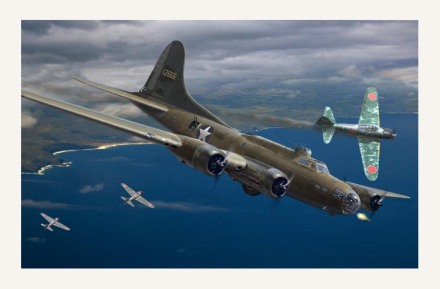
6/16/1943 - "Old 666" In Action
Kudos and thanks to the "Old 666,' and the men that crewed her ... may they all rest in peace.
My compliments on choosing to bring more attention to this remarkable, historic crew. I see a few errors, but there are so many inaccurate accounts online, it can be hard to root them out without heavy research. I know this from personal experience: I've spent almost thirty years researching the crew to get to the real story and attempt to correct the record about them. It's that personal research that my website dedicated to the crew, zeamerseagerbeavers.com, is based on, including interviews with the crew members themselves and their squadron mates. It appears you may have found it helpful in researching and illustrating your piece here, but if not, I invite you and anyone else who wants to take a comprehensive dive into the crew, their story, and facts about '666, to visit.
ReplyDelete